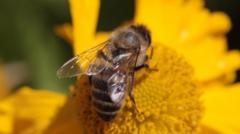What Caused the Bee Attack That Left Three Critical and Dozens Injured in France?

Understanding the Unusual Bee Attack in Aurillac: Causes, Impact, and Safety Measures
The recent bee attack in Aurillac, France, has left the community reeling and raised questions about the behavior of these vital pollinators. With 24 individuals injured and three in critical condition, this incident has sparked concerns about safety in areas where bees are prevalent. This article delves into the details of the incident, potential causes, and what it means for residents and beekeepers alike.
What Happened During the Bee Attack in Aurillac?
On a seemingly ordinary Sunday morning, the French town of Aurillac was suddenly engulfed in chaos. Hundreds of bees launched an unexpected attack on passersby, resulting in 24 injuries. Among the injured, a 78-year-old woman was particularly affected, suffering 25 stings and requiring resuscitation due to a cardiorespiratory arrest. The rapid response of local police and firefighters was crucial in managing the situation, as they quickly fenced off the area to protect onlookers while a beekeeper was called in to calm the agitated bees.
Immediate Response to the Attack
The swift actions taken by emergency services highlighted the seriousness of the situation. Here’s how the response unfolded:
- Emergency Services: Police and firefighters arrived to secure the area, ensuring that no further injuries occurred.
- Beekeeper Intervention: A beekeeper utilized smoke to pacify the bees, a common technique to calm aggressive insect behavior.
- Medical Assistance: Injured individuals received immediate medical attention, with critical cases being rushed to the hospital.
Potential Causes Behind the Bee Attack
The mayor of Aurillac, Pierre Mathonier, suggested that the incident may have been provoked by the presence of Asian hornets threatening a nearby beehive. However, this explanation has been met with skepticism by experts in the field.
Expert Opinions on the Incident
Christian Carrier, president of the regional beekeepers' union, offered a different perspective. He indicated that bees typically avoid leaving their colonies in the presence of Asian hornets. Instead, he posited that the attack might have resulted from the colony becoming too large for its hive, leading to aggressive behavior when the beekeeper attempted to manage it. Some of the likely causes include:
- Overactivity: A crowded colony can become agitated, especially if the bees feel their space is being threatened.
- Swarming Behavior: Bees may exhibit aggression if they sense imminent swarming, a natural reproductive process where a portion of the colony leaves to form a new hive.
- Colony Stress: Factors such as environmental stressors, artificial handling, or disturbances can amplify aggression in bee colonies.
The Importance of Bees: Understanding Their Behavior
Bees play a crucial role in our ecosystem as pollinators. However, understanding their behavior is essential for preventing such dangerous encounters. Here are some key points to consider:
Bee Behavior and Aggression
While bees are typically not aggressive, certain conditions can trigger defensive behaviors:
- Defending the Hive: Bees will aggressively defend their hive if they perceive a threat.
- Colony Size: Larger colonies, especially when confined, may exhibit heightened aggression.
- Environmental Factors: Changes in habitat, food scarcity, or threats from other species can lead to increased defensive behaviors.
Safety Measures for Residents and Visitors
Given the potential risk of bee attacks, it is vital for residents and visitors to be aware of safety measures. Here are some recommendations:
Tips to Avoid Bee Attacks
- Avoid Bright Colors: Bees are attracted to bright colors; wearing subdued clothing can help reduce attraction.
- Stay Calm: If bees approach, remain calm and avoid swatting at them, which may provoke aggression.
- Be Aware of Surroundings: Stay alert in areas known for beehives, particularly in warmer months when bees are more active.
- Report Swarms: Inform local authorities if you notice aggressive bee activity or swarms in public spaces.
The Role of Beekeepers in Community Safety
Beekeepers play an essential role in maintaining healthy bee populations while ensuring community safety. Here’s how they contribute:
Responsibilities of Beekeepers
- Regular Monitoring: Beekeepers should regularly inspect hives for signs of overpopulation or stress.
- Education: Providing education to the community about bee behavior and safety can foster better coexistence.
- Responsible Management: Implementing best practices for hive management to prevent aggressive behaviors and swarming.
Conclusion: A Call for Awareness and Understanding
The unfortunate incident in Aurillac serves as a reminder of the delicate balance between humans and nature. While bees are vital for our ecosystem, it’s crucial to understand their behavior and the circumstances that can lead to dangerous encounters. By educating ourselves and taking appropriate safety measures, we can coexist with these important pollinators while minimizing risks.
As we move forward, let us remain vigilant and informed about bee behavior and the ecological significance they hold. Will we take this opportunity to foster a greater understanding and respect for our buzzing neighbors, ensuring a harmonious relationship between humans and bees? #BeeSafety #Aurillac #Pollinators
FAQs
What should I do if I encounter a swarm of bees?
If you encounter a swarm of bees, the best course of action is to remain calm, avoid sudden movements, and slowly walk away from the area. Do not attempt to swat at the bees, as this may provoke them.
Are bee attacks common?
Bee attacks are relatively rare, but they can occur, especially when bees feel threatened or if their hive is disturbed. Understanding bee behavior can help mitigate risks.
How can I support local beekeepers?
You can support local beekeepers by purchasing honey and bee-related products, participating in community education programs, and advocating for bee-friendly practices in your area.
Published: 2025-07-08 10:37:05 | Category: world



